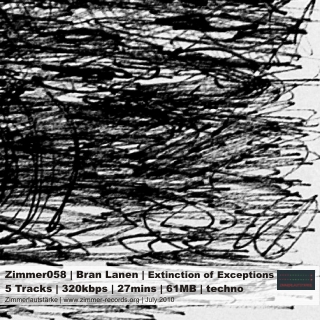Zimmer058 – bran lanen – extinction of exceptions (spain)
mp3, 320kbps, stereo, deep, tool, techno
058.01 – Bran Lanen – Exception One
058.02 – Bran Lanen – Exception Two
058.03 – Bran Lanen – Exception Three
058.04 – Bran Lanen – Exception Four
058.05 – Bran Lanen – Extinction
download & stream -> archive.org
download & stream -> sonicsquirrel.net
download & stream -> last.fm
download ZIP (MP3 | 61MB)
Artwork (666px)
[by nadrealizam]
A species is extinct when the last existing member dies. Extinction therefore becomes a certainty when there are no surviving individuals that can reproduce and create a new generation. A species may become functionally extinct when only a handful of individuals survive, which cannot reproduce due to poor health, age, sparse distribution over a large range, a lack of individuals of both sexes (in sexually reproducing species), or other reasons.
Pinpointing the extinction (or pseudoextinction) of a species requires a clear definition of that species. If it is to be declared extinct, the species in question must be uniquely distinguishable from any ancestor or daughter species, and from any other closely related species. Extinction of a species (or replacement by a daughter species) plays a key role in the punctuated equilibrium hypothesis of Stephen Jay Gould and Niles Eldredge.
In ecology, extinction is often used informally to refer to local extinction, in which a species ceases to exist in the chosen area of study, but may still exist elsewhere. This phenomenon is also known as extirpation. Local extinctions may be followed by a replacement of the species taken from other locations; wolf reintroduction is an example of this. Species which are not extinct are termed extant. Those that are extant but threatened by extinction are referred to as threatened or endangered species.
Currently an important aspect of extinction is human attempts to preserve critically endangered species. These are reflected by the creation of the conservation status “Extinct in the Wild” (EW). Species listed under this status by the International Union for Conservation of Nature (IUCN) are not known to have any living specimens in the wild, and are maintained only in zoos or other artificial environments. Some of these species are functionally extinct, as they are no longer part of their natural habitat and it is unlikely the species will ever be restored to the wild. When possible, modern zoological institutions try to maintain a viable population for species preservation and possible future reintroduction to the wild, through use of carefully planned breeding programs.
The extinction of one species’ wild population can have knock-on effects, causing further extinctions. These are also called “chains of extinction”. This is especially common with extinction of keystone species.
In biology and ecology, extinction is the end of an organism or group of taxa. The moment of extinction is generally considered to be the death of the last individual of that species (although the capacity to breed and recover may have been lost before this point). Because a species’ potential range may be very large, determining this moment is difficult, and is usually done retrospectively. This difficulty leads to phenomena such as Lazarus taxa, where a species presumed extinct abruptly “re-appears” (typically in the fossil record) after a period of apparent absence.//wikipedia
